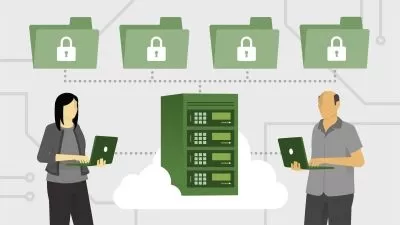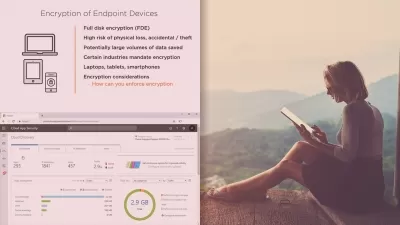SC-400 Course Microsoft Information Protection Administrator
John Christopher
6:30:58
Description
Get prepared for the SC-400 exam with instructor led labs and hands on simulations available 24/7
What You'll Learn?
- Learn the concepts and perform hands on activities needed to pass the SC-400 exam
- Gain a tremendous amount of knowledge involving Microsoft 365 and Azure Services
- Get loads of hands on experience with Microsoft Information Protection Services!
- Utilize hands on simulations that can be access anytime, anywhere!
Who is this for?
What You Need to Know?
More details
DescriptionWe really hope you'll agree, this training is way more then the average course on Udemy!
Have access to the following:
Training from an instructor of over 20 years who has trained thousands of people and also a Microsoft Certified Trainer
Lecture that explains the concepts in an easy to learn method for someone that is just starting out with this material
Instructor led hands on and simulations to practice that can be followed even if you have little to no experience
TOPICS COVEREDÂ INCLUDINGÂ HANDSÂ ONÂ LECTUREÂ ANDÂ PRACTICEÂ TUTORIALS:
Introduction
Welcome to the course
Understanding the Microsoft Environment
A Solid Foundation of Active Directory Domains
A Solid Foundation of RAS, DMZ, and Virtualization
A Solid Foundation of the Microsoft Cloud Services
Creating a free Microsoft 365 Azure AD Account
Managing Microsoft 365 Services with PowerShell
Connecting to Security and Compliance using PowerShell
IMPORTANT Using Assignments in the course
Creating and Managing Sensitive Information Types
Selecting a Sensitive Information Type based on an Organization's Requirements
Creating and Managing Custom Sensitive Information Types
Creating Custom Sensitive Information Types with exact data match
Understanding Document Fingerprinting
Creating a Keyword Dictionary
Trainable Classifiers
Understanding Trainable Classifiers
Getting Started with Trainable Classifiers
Implementing and Managing Sensitivity Labels
Understanding Sensitivity Labels
Identifying Roles and Permissions for Administering Sensitivity Labels
Enabling Audit Logging before working with Sensitivity Labels
Creating Sensitivity Labels including with Email, Content Marking and Encryption Settings
Configuring and Managing Sensitivity Label Policies
Applying Sensitivity Labels to Microsoft Teams, Microsoft 365 groups, and SharePoint sites
Configuring and Publishing Automatic Labeling Policies (excluding MCAS scenarios)
Viewing Sensitivity Labels as an end user
Monitoring Data Classification and Label usage by using Label Analytics Tools such as content explorer and activity explorer
Design and implement encryption for email messages
Design an email encryption solution based on methods available in Microsoft 365
Implement Microsoft Purview Message Encryption
Implement Microsoft Purview Advanced Message Encryption
Creating and Configuring Data Loss Prevention Policies
Understanding the purpose of Data Loss Prevention
Recommending a Data Loss Prevention Solution for an Organization
Configuring Data Loss Prevention for Policy Precedence
Configuring policies for Exchange, SharePoint, OneDrive and Teams
Configuring the custom advanced settings in Data Loss Prevention policies
Editing the default Office 365 Data Loss Prevention Policy
Understanding Microsoft Cloud App Security (MCAS)
Configuring policies in Microsoft Cloud App Security (MCAS)
Implementing Data Loss Prevention Policies in Test Mode
Implementing and Monitoring Microsoft Endpoint Data Loss Prevention
Setting up proper licensing for Microsoft Endpoint Data Loss Prevention
Configuring Policies for Endpoints
Configuring Endpoint Data Loss Prevention Settings
Recommending Configurations that enable devices for Endpoint Data Loss Prevention Policies
Monitoring Endpoint Activities and Reports for Policy Violations
Retain and delete data by using retention labels
Plan for information retention and disposition by using retention labels
Create retention labels for data lifecycle management
Configure and manage adaptive scopes
Configure a retention label policy to publish labels
Configure a retention label policy to auto-apply labels
Interpret the results of policy precedence, including using Policy lookup
Manage data retention in Microsoft 365 workloads
Create and apply retention policies for SharePoint and OneDrive
Create and apply retention policies for Microsoft 365 groups
Create and apply retention policies for Teams
Create and apply retention policies for Engage (formerly Yammer)
Create and apply retention policies for Exchange Online
Apply mailbox holds in Exchange Online
Implement Exchange Online archiving
Configure preservation locks for retention policies and retention label policies
Recover retained content in Microsoft 365
Implementing Records Management in Microsoft 365
Configuring Labels for Records Management
Managing and Migrating Retention Requirements with a File Plan
Configuring Automatic Retention and Sensitivity Classification Records using File Plan Descriptors
Implementing In-Place Records Management in Microsoft SharePoint
Managing Disposition of Records
Plan and manage eDiscovery and Content search
Choose between eDiscovery (Standard) and eDiscovery (Premium)
Delegate permissions and perform Content search
Perform searches and respond to results from eDiscovery
Manage and analyze audit logs and reports in Microsoft Purview
Choose between Audit (Standard) & Audit (Premium) based on an orgs requirements
Plan for and configure auditing
Investigate activities by using the unified audit log
Review and interpret compliance reports and dashboards using compliance manager
Configure alert policies
Configure audit retention policies
Implement and manage Microsoft Purview Communication Compliance
Plan for communication compliance
Create and manage communication compliance policies
Investigate and remediate communication compliance alerts and reports
Implement and manage Microsoft Purview Insider Risk Management
Plan for insider risk management
Create and manage insider risk management policies
Investigate and remediate insider risk activities, alerts, and reports
Manage inside risk cases, forensic evidence settings, and notice templates
Implement and manage Microsoft Purview Information Barriers (IBs)
Plan for IBs
Create and manage IB segments and policies
Configure Teams, SharePoint, & OneDrive to enforce IBs, including IB modes
Investigate issues with IB policies
Implement and manage privacy requirements by using Microsoft Priva
Configure and maintain privacy risk management
Create and manage Privacy Risk Management policies
Understanding subject rights requests
Who this course is for:
- IT people interested in learning and passing the Microsoft SC-400 Exam
- People interested in learning a tremendous amount about Microsoft 365 Information Protection Services
We really hope you'll agree, this training is way more then the average course on Udemy!
Have access to the following:
Training from an instructor of over 20 years who has trained thousands of people and also a Microsoft Certified Trainer
Lecture that explains the concepts in an easy to learn method for someone that is just starting out with this material
Instructor led hands on and simulations to practice that can be followed even if you have little to no experience
TOPICS COVEREDÂ INCLUDINGÂ HANDSÂ ONÂ LECTUREÂ ANDÂ PRACTICEÂ TUTORIALS:
Introduction
Welcome to the course
Understanding the Microsoft Environment
A Solid Foundation of Active Directory Domains
A Solid Foundation of RAS, DMZ, and Virtualization
A Solid Foundation of the Microsoft Cloud Services
Creating a free Microsoft 365 Azure AD Account
Managing Microsoft 365 Services with PowerShell
Connecting to Security and Compliance using PowerShell
IMPORTANT Using Assignments in the course
Creating and Managing Sensitive Information Types
Selecting a Sensitive Information Type based on an Organization's Requirements
Creating and Managing Custom Sensitive Information Types
Creating Custom Sensitive Information Types with exact data match
Understanding Document Fingerprinting
Creating a Keyword Dictionary
Trainable Classifiers
Understanding Trainable Classifiers
Getting Started with Trainable Classifiers
Implementing and Managing Sensitivity Labels
Understanding Sensitivity Labels
Identifying Roles and Permissions for Administering Sensitivity Labels
Enabling Audit Logging before working with Sensitivity Labels
Creating Sensitivity Labels including with Email, Content Marking and Encryption Settings
Configuring and Managing Sensitivity Label Policies
Applying Sensitivity Labels to Microsoft Teams, Microsoft 365 groups, and SharePoint sites
Configuring and Publishing Automatic Labeling Policies (excluding MCAS scenarios)
Viewing Sensitivity Labels as an end user
Monitoring Data Classification and Label usage by using Label Analytics Tools such as content explorer and activity explorer
Design and implement encryption for email messages
Design an email encryption solution based on methods available in Microsoft 365
Implement Microsoft Purview Message Encryption
Implement Microsoft Purview Advanced Message Encryption
Creating and Configuring Data Loss Prevention Policies
Understanding the purpose of Data Loss Prevention
Recommending a Data Loss Prevention Solution for an Organization
Configuring Data Loss Prevention for Policy Precedence
Configuring policies for Exchange, SharePoint, OneDrive and Teams
Configuring the custom advanced settings in Data Loss Prevention policies
Editing the default Office 365 Data Loss Prevention Policy
Understanding Microsoft Cloud App Security (MCAS)
Configuring policies in Microsoft Cloud App Security (MCAS)
Implementing Data Loss Prevention Policies in Test Mode
Implementing and Monitoring Microsoft Endpoint Data Loss Prevention
Setting up proper licensing for Microsoft Endpoint Data Loss Prevention
Configuring Policies for Endpoints
Configuring Endpoint Data Loss Prevention Settings
Recommending Configurations that enable devices for Endpoint Data Loss Prevention Policies
Monitoring Endpoint Activities and Reports for Policy Violations
Retain and delete data by using retention labels
Plan for information retention and disposition by using retention labels
Create retention labels for data lifecycle management
Configure and manage adaptive scopes
Configure a retention label policy to publish labels
Configure a retention label policy to auto-apply labels
Interpret the results of policy precedence, including using Policy lookup
Manage data retention in Microsoft 365 workloads
Create and apply retention policies for SharePoint and OneDrive
Create and apply retention policies for Microsoft 365 groups
Create and apply retention policies for Teams
Create and apply retention policies for Engage (formerly Yammer)
Create and apply retention policies for Exchange Online
Apply mailbox holds in Exchange Online
Implement Exchange Online archiving
Configure preservation locks for retention policies and retention label policies
Recover retained content in Microsoft 365
Implementing Records Management in Microsoft 365
Configuring Labels for Records Management
Managing and Migrating Retention Requirements with a File Plan
Configuring Automatic Retention and Sensitivity Classification Records using File Plan Descriptors
Implementing In-Place Records Management in Microsoft SharePoint
Managing Disposition of Records
Plan and manage eDiscovery and Content search
Choose between eDiscovery (Standard) and eDiscovery (Premium)
Delegate permissions and perform Content search
Perform searches and respond to results from eDiscovery
Manage and analyze audit logs and reports in Microsoft Purview
Choose between Audit (Standard) & Audit (Premium) based on an orgs requirements
Plan for and configure auditing
Investigate activities by using the unified audit log
Review and interpret compliance reports and dashboards using compliance manager
Configure alert policies
Configure audit retention policies
Implement and manage Microsoft Purview Communication Compliance
Plan for communication compliance
Create and manage communication compliance policies
Investigate and remediate communication compliance alerts and reports
Implement and manage Microsoft Purview Insider Risk Management
Plan for insider risk management
Create and manage insider risk management policies
Investigate and remediate insider risk activities, alerts, and reports
Manage inside risk cases, forensic evidence settings, and notice templates
Implement and manage Microsoft Purview Information Barriers (IBs)
Plan for IBs
Create and manage IB segments and policies
Configure Teams, SharePoint, & OneDrive to enforce IBs, including IB modes
Investigate issues with IB policies
Implement and manage privacy requirements by using Microsoft Priva
Configure and maintain privacy risk management
Create and manage Privacy Risk Management policies
Understanding subject rights requests
Who this course is for:
- IT people interested in learning and passing the Microsoft SC-400 Exam
- People interested in learning a tremendous amount about Microsoft 365 Information Protection Services
User Reviews
Rating
John Christopher
Instructor's Courses
Udemy
View courses Udemy- language english
- Training sessions 62
- duration 6:30:58
- English subtitles has
- Release Date 2024/05/21











